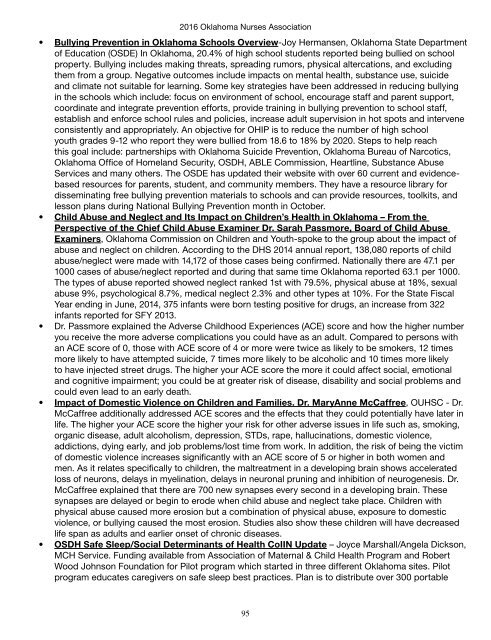2016 Oklahoma Annual Book of Reports
Create successful ePaper yourself
Turn your PDF publications into a flip-book with our unique Google optimized e-Paper software.
<strong>2016</strong> <strong>Oklahoma</strong> Nurses Association<br />
• Bullying Prevention in <strong>Oklahoma</strong> Schools Overview-Joy Hermansen, <strong>Oklahoma</strong> State Department<br />
<strong>of</strong> Education (OSDE) In <strong>Oklahoma</strong>, 20.4% <strong>of</strong> high school students reported being bullied on school<br />
property. Bullying includes making threats, spreading rumors, physical altercations, and excluding<br />
them from a group. Negative outcomes include impacts on mental health, substance use, suicide<br />
and climate not suitable for learning. Some key strategies have been addressed in reducing bullying<br />
in the schools which include: focus on environment <strong>of</strong> school, encourage staff and parent support,<br />
coordinate and integrate prevention efforts, provide training in bullying prevention to school staff,<br />
establish and enforce school rules and policies, increase adult supervision in hot spots and intervene<br />
consistently and appropriately. An objective for OHIP is to reduce the number <strong>of</strong> high school<br />
youth grades 9-12 who report they were bullied from 18.6 to 18% by 2020. Steps to help reach<br />
this goal include: partnerships with <strong>Oklahoma</strong> Suicide Prevention, <strong>Oklahoma</strong> Bureau <strong>of</strong> Narcotics,<br />
<strong>Oklahoma</strong> Office <strong>of</strong> Homeland Security, OSDH, ABLE Commission, Heartline, Substance Abuse<br />
Services and many others. The OSDE has updated their website with over 60 current and evidencebased<br />
resources for parents, student, and community members. They have a resource library for<br />
disseminating free bullying prevention materials to schools and can provide resources, toolkits, and<br />
lesson plans during National Bullying Prevention month in October.<br />
• Child Abuse and Neglect and Its Impact on Children’s Health in <strong>Oklahoma</strong> – From the<br />
Perspective <strong>of</strong> the Chief Child Abuse Examiner Dr. Sarah Passmore, Board <strong>of</strong> Child Abuse<br />
Examiners, <strong>Oklahoma</strong> Commission on Children and Youth-spoke to the group about the impact <strong>of</strong><br />
abuse and neglect on children. According to the DHS 2014 annual report, 138,080 reports <strong>of</strong> child<br />
abuse/neglect were made with 14,172 <strong>of</strong> those cases being confirmed. Nationally there are 47.1 per<br />
1000 cases <strong>of</strong> abuse/neglect reported and during that same time <strong>Oklahoma</strong> reported 63.1 per 1000.<br />
The types <strong>of</strong> abuse reported showed neglect ranked 1st with 79.5%, physical abuse at 18%, sexual<br />
abuse 9%, psychological 8.7%, medical neglect 2.3% and other types at 10%. For the State Fiscal<br />
Year ending in June, 2014, 375 infants were born testing positive for drugs, an increase from 322<br />
infants reported for SFY 2013.<br />
• Dr. Passmore explained the Adverse Childhood Experiences (ACE) score and how the higher number<br />
you receive the more adverse complications you could have as an adult. Compared to persons with<br />
an ACE score <strong>of</strong> 0, those with ACE score <strong>of</strong> 4 or more were twice as likely to be smokers, 12 times<br />
more likely to have attempted suicide, 7 times more likely to be alcoholic and 10 times more likely<br />
to have injected street drugs. The higher your ACE score the more it could affect social, emotional<br />
and cognitive impairment; you could be at greater risk <strong>of</strong> disease, disability and social problems and<br />
could even lead to an early death.<br />
• Impact <strong>of</strong> Domestic Violence on Children and Families. Dr. MaryAnne McCaffree, OUHSC - Dr.<br />
McCaffree additionally addressed ACE scores and the effects that they could potentially have later in<br />
life. The higher your ACE score the higher your risk for other adverse issues in life such as, smoking,<br />
organic disease, adult alcoholism, depression, STDs, rape, hallucinations, domestic violence,<br />
addictions, dying early, and job problems/lost time from work. In addition, the risk <strong>of</strong> being the victim<br />
<strong>of</strong> domestic violence increases significantly with an ACE score <strong>of</strong> 5 or higher in both women and<br />
men. As it relates specifically to children, the maltreatment in a developing brain shows accelerated<br />
loss <strong>of</strong> neurons, delays in myelination, delays in neuronal pruning and inhibition <strong>of</strong> neurogenesis. Dr.<br />
McCaffree explained that there are 700 new synapses every second in a developing brain. These<br />
synapses are delayed or begin to erode when child abuse and neglect take place. Children with<br />
physical abuse caused more erosion but a combination <strong>of</strong> physical abuse, exposure to domestic<br />
violence, or bullying caused the most erosion. Studies also show these children will have decreased<br />
life span as adults and earlier onset <strong>of</strong> chronic diseases.<br />
• OSDH Safe Sleep/Social Determinants <strong>of</strong> Health CoIIN Update – Joyce Marshall/Angela Dickson,<br />
MCH Service. Funding available from Association <strong>of</strong> Maternal & Child Health Program and Robert<br />
Wood Johnson Foundation for Pilot program which started in three different <strong>Oklahoma</strong> sites. Pilot<br />
program educates caregivers on safe sleep best practices. Plan is to distribute over 300 portable<br />
95

















